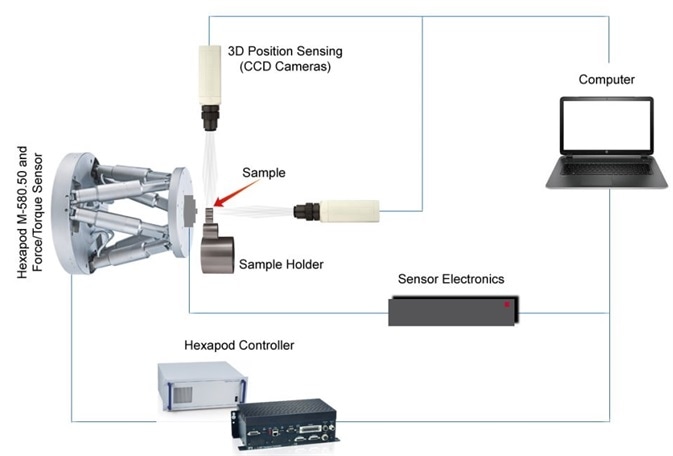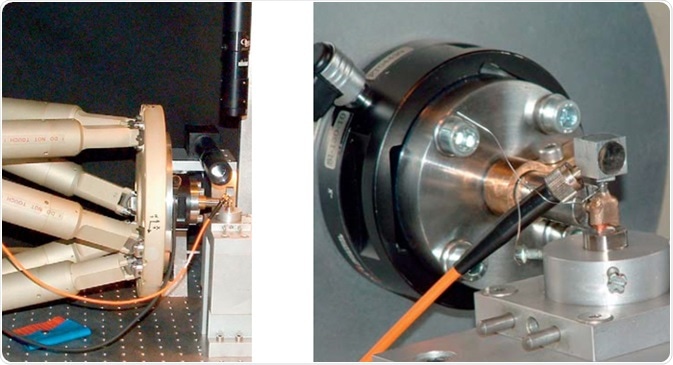Introduction
Hexapod motion and positioning platforms are flexible based on a programmable center of rotation and can deliver precision motion in all degrees of freedom, making them the mainstream equipment for use in optics, physics, and engineering applications. As hexapods turn out to be more mainstream, they find their use in the medical field as well.
Dental biomechanics
Dental biomechanics handles the interactions between treatment instruments, dentures or dental materials, and the reaction of biological tissues or teeth, etc. to mechanical stresses. A broad range of force systems are available here with torques to several Nm and masticatory forces applying loads to 380 N.
Dental biomechanics also involves the movements of several orders of magnitude: The teeth position can be changed by up to several millimeters by the orthodontic equipment. However, the deflection of the teeth and implants during mastication is below 100 µm and down to a few microns or less, respectively. The combinations of these large forces and very small deflections on one hand, and extremely small forces with very large deflections on the other hand, pose a challenge with regard to the biomechanical metrology.
HexMeS
To address this challenge, a Hexa-pod Measuring System (HexMeS) was designed based on PI’s M-850 high load hexapod by the Dental Clinic of the University of Bonn. The reason behind the selection of the hexapod motion system was its ability to travel in all six axes within a highly stiff, small package at resolutions down to 1 µm (1 arcsec).

HexMeS also features two 6-component force/torque sensors for the Hexapod with measuring ranges of 12 N (120 Nmm) and 130 N (10 Nm) respectively and an optical detection system equipped with 3 CCD cameras. (Image: University of Bonn)
The high hexapod stiffness of 100 N/µm enables direct calculation of deflections from the Hexapod motion. The HexMeS’ optical sensor is employed for high-load testing – simulations of mastication within the range of 100 N, providing resolution down to 0.7 µm / 0.2 arcsec. The system performance has been evaluated with orthodontic prostheses, telescope crowns, and dental implants.
Scientists at the University of Ulm have carried out additional research to achieve better simulation results. They focused on the adaptation of orthodontic equipment to better understand how a tooth (elastically embedded in the jaw bone) responds to torques and forces. However, it is not possible to perform the measurements in vivo directly on a patient.
A clear answer cannot be obtained by only performing FEA simulation due to the involvement of too many unknowns, for example, the biomechanical behavior of the connective tissue of the periodontal ligament (PDL).

Load testing of a double crown with the high-stiffness hexapod 6-axis motion system (Image: University of Bonn)
Researchers from the University of Ulm attempted a different approach by using realistic simulations on a model. The resulting numerically controlled experimental setup can be used to measure the clinically relevant forces experienced by the tooth when subjected to orthodontic motion. This approach allows checking and modification of FEA models based on real measurements.
The small movements of a tooth positioned in the jawbone can be simulated using a Hexapod with a programmable center of rotation and six degrees of freedom motion. A force sensor placed over a rigid rotary table was used along with the Hexapod for simulation. A phantom tooth, which is essentially an orthodontic bracket, is directly mounted on the sensor. The positioning accuracy and high stiffness of the Hexapod allow the force exerted on the sample to be exactly assigned to a position, enabling determination of the stress points at the tooth.

The force sensor is mounted on the top platform of the Hexapod. It simulates a real tooth and registers all acting forces and torques, while the hexapod moves the test specimen in small steps. The platform is controlled by a special algorithm that simulates the elastic behavior of the periodontal ligament. (Image: University of Ulm)

The tooth reconstructed from radiological data is embedded in the red-colored periodontal ligament (shown without the bone). The loads act on the points shown in the middle portion of the tooth crown as yellow spheres. (Image: University of Ulm)
Conclusion
The results acquired with the simulation model help evaluate orthodontic processes in the oral cavity in a better manner and achieve a more efficient design of corrective measures. It is also possible to achieve similar results in other areas like hip and dental implants using appropriate test setups.
Acknowledgments
Created from materials written by Christoph Bourauel and Ludger Keilig, Department for Orthodontics Friedrich-Wilhelms- Universität, Bonn; Martin Geiger, Research Assistant at the University, Hospital of Ulm, Hospital for Orthodontics; Birgit Bauer, Business Development Manager Health, PI (Physik Instrumente)
About PI
PI is a leading manufacturer of precision motion control systems such as Piezo Nanopositioning Systems, Air Bearings, Linear Motor Stages, Microscope Stages, Motion Controllers, Piezo Flexure Mechanisms, Piezo Ceramic Motors and Hexapod 6-Axis Stages -- for photonics, bio-nanotechnology, medical device & semiconductor applications.
PI recently acquired the majority of ACS, a global leader in high-end motion controllers for precision industrial automation. PI USA is also specialized in Air Bearing positioning systems boasting over 200 man-years of in-house air bearing design experience.
Linear, planar XY, and rotary air bearing stages and custom turnkey systems are available to serve industrial and research markets. Piezo actuators from our PI Ceramic division and precision stages from our PI miCos division were selected by NASA for the Mars Mission and are employed on in the Curiosity rover science lab. PI has been developing and manufacturing standard & custom precision products with piezoceramic and electromagnetic drives for 40 years.
Sponsored Content Policy: News-Medical.net publishes articles and related content that may be derived from sources where we have existing commercial relationships, provided such content adds value to the core editorial ethos of News-Medical.Net which is to educate and inform site visitors interested in medical research, science, medical devices and treatments.